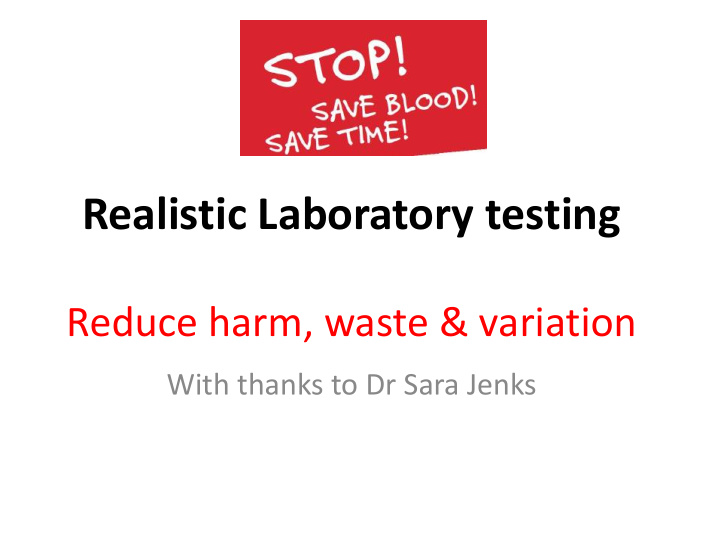



Realistic Laboratory testing Reduce harm, waste & variation With thanks to Dr Sara Jenks
The problem • ˜5.5 million primary care haem/ biochem tests p.a. • Many tests may be ‘inappropriate’ - ?? Up to 25% • Why – defensive medicine, habit, ordersets, repeat requests, patient demand, lack of consideration of cost, lack of experience, uncertainty, guidelines (or lack of)
Optimising benefit Number of tests
Reference ranges • Defined using a “healthy” population • Impact of age, gender, medications, diet, exercise
Benefits of reducing inappropriate requests • More appropriate use of doctor and phlebotomist (less tests to do and less results to check) • Reduced cost • Improved lab efficiency • Potentially better patient experience • Avoidance of harm arising from over- investigation
Rise in Requesting Vitamin D requests 1400 1200 1000 800 600 400 200 0 2013 2014 2015 2016 2017
Impact on other associated tests 8000 7000 6000 5000 25OH VitD imm'assay 4000 Calcium PTH Phosphate 3000 2000 1000 0 2013 2014 2015 2016 2017
Is this cost-effective, quality care? Increase in testing from 2012 equates to approx: – Vit D - £7.52 per test =£67,000 p.a. – Ca - £0.53 = £15,900 – P - £0.60 = £7,200 – PTH - £2.85 = £10,200 • Approx increase in lab spending p.a. = £100,000 • Also – GP appointments, prescription costs • Balanced against costs associated with osteomalacia/osteoporosis
B12 & Folate 5000 4500 4000 3500 3000 Vitamin B12 2500 Serum Folate 2000 1500 1000 500 0 2013 2014 2015 2016 2017 B12 = £1.35 Folate = £1.26 - increase approx £30,000 per annum
Coeliac testing 3000 2500 2000 1500 1000 500 0 2013 2014 2015 2016 2017 TTG IgA =£11.86 = increase equates to £149,000 p.a.
Reduction in testing Urea requests 45000 40000 35000 30000 25000 20000 15000 10000 5000 0 2013 2014 2015 2016 2017 Reduction in urea saved £28,000 – has there been any harm?
Variation in requesting
Communicating variation
Lothian work • Removed urea from C&Es • Reducing frequency of interval testing in patients with stable TFTs (non child bearing age only) • Vitamin D guidance • LFTs – ALT only in statins – ?removal of GGT • Urinalysis guidance • PCR/ACR • FSH • Test prices displayed for secondary care
Ideas from other healthboards • Fife – blocked repeat lipids within 8 weeks, vitamin D blocked if Ca/P/ALP normal • Glasgow – Duty biochemist reviews tests within certain repeat intervals • D&G – FSH blocked in women over 45 years • GP variation data – used in Grampian, fife • England – separation of Creatinine from Na/K
When is automatically cascading tests more appropriate? • Intelligent LFTs – Tayside pilot successful • GP selects iLFTs – question re:BMI, alcohol intake answered and basic LFT panel checked • Lab automatically cascades Hepatitis B, C serology, autoantibodies, caeruloplasmin, ferritin, fibrosis scores, as appropriate • Results returned to GP with probable diagnosis, indication of presence of fibrosis and suggestion of whether to refer patient
Summary • Over-requesting can both increase costs and may impact negatively on quality of care • Education and guidance may reduce requesting but needs regular reinforcement • The psychology of why tests are being over-requested is important • Balancing measures outside the laboratory need to be considered • Engagement with clinicians is vital • Quality of care & patient safety are most important considerations • Realistic lab medicine isn’t just about reducing testing but also about using tests more effectively
Ideas for discussion • Where would updated testing guidelines be useful? • Are there any tests in profiles which you feel could be removed e.g. GGT from LFTs • GPOC/ICE changes • Visibility of test prices on ICE • When is automatically cascading tests more efficient? • Is showing data on the variation between practices useful? • Is blocking tests ever the solution?
Recommend
More recommend